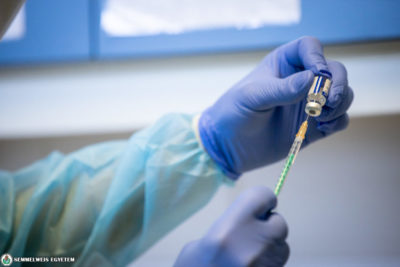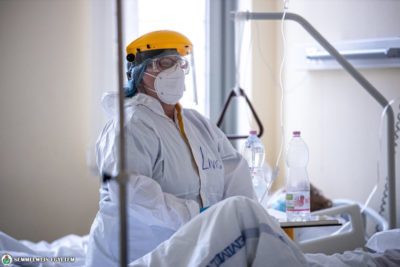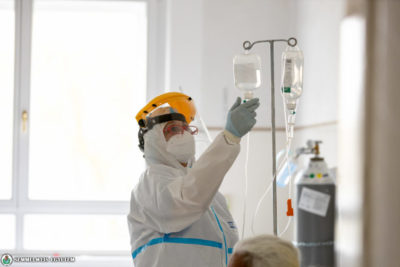Semmelweis University has been involved in the care of coronavirus patients since the outbreak of the epidemic, and nearly 6,000 COVID-19 patients have been treated at university departments since the beginning of the first wave. As part of our series about units providing COVID care, we now present the Department of Internal Medicine and Hematology, the Department of Urology, and the Department of Orthopedics.
“Keeping the Inner Clinical Block COVID-free was one of our main responsibilities”
Dr. Tamás Masszi, Director, Department of Internal Medicine and Hematology
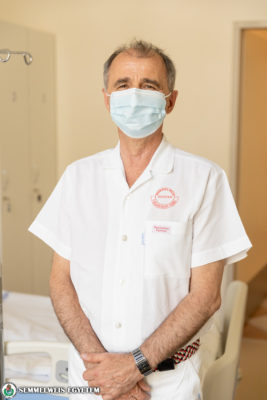 “The primary responsibility of the Department of Internal Medicine and Hematology was initially to protect the Inner Clinical Block and to keep it COVID-free. In the building on Szentkirályi utca, at the beginning of the epidemic a so-called grey zone was established and all patients suspected of having a coronavirus infection were admitted by this department. The presence of COVID-19 was ruled out by two PCR tests performed with a time difference of 48 hours, during which time the patients were treated as if they were COVID-infected”, said Dr. Tamás Masszi.
“The primary responsibility of the Department of Internal Medicine and Hematology was initially to protect the Inner Clinical Block and to keep it COVID-free. In the building on Szentkirályi utca, at the beginning of the epidemic a so-called grey zone was established and all patients suspected of having a coronavirus infection were admitted by this department. The presence of COVID-19 was ruled out by two PCR tests performed with a time difference of 48 hours, during which time the patients were treated as if they were COVID-infected”, said Dr. Tamás Masszi.
He added that this caution helped to prevent the appearance of the infection in the clinical block, and in the meantime they were also providing internal medical care within the university. He highlighted the importance of their ability to treat internal medicine cases on an ongoing basis no matter how large the number of COVID patients treated at the university was at the peaks of the epidemic, and the medical examinations essential for a diagnosis were also performed on a timely manner. As the director emphasized, this is due to the fact that the university has an extensive diagnostic capacity and extremely dedicated people work in this field as well.
The department has participated in direct COVID patient care since 1 October 2020, and set up its own COVID care unit on the 4th floor of the Tömő Street Epidemic Block with a capacity of 28 hospital beds. The unit on the 5th floor was operated jointly by the Department of Internal Medicine and Hematology and the Department of Internal Medicine and Oncology.
“Bearing in mind a fair sharing of the public burden, our colleagues worked here in a rotating system, with a change of working locations in about every two months. Based on the conversations with my colleagues, there is a consensus that caring for patients who had a difficulty with breathing was the most difficult mental burden, but it was of course a challenge to learn to examine patients while wearing protective clothing and to be able to communicate properly with our patients. We paid special attention to convey human gestures and kindness, since the protective clothing we were wearing sometimes evoked fear in many patients”, said Dr. Tamás Masszi.
The COVID unit operated by the Department of Internal Medicine and Hematology primarily treated patients who had an underlying internal medicine disease in addition to COVID-19 infection, but the unit also provided general COVID patient care as well. As Dr. Tamás Masszi pointed out, it is an important experience that many people were hospitalized because of their underlying disease and it was only incidentally found out that they were also infected with coronavirus.
According to the director, one of the lessons of the pandemic is that creating areas allowing patient isolation should always be considered by future developments. It is an interesting experience that the increased routine of hand disinfection and the wearing of masks and protective clothing have completely suppressed the otherwise relatively common viral or bacterial infections. Dr. Tamás Masszi also highlighted that their COVID care team was complemented by residents from other departments and medical students, and it was a great pleasure to see how effectively they could provide support after a short training session.
“Loyalty, a positive attitude, and empathy for patients have become even more important”
Dr. Péter Nyirády, Director, Department of Urology
 “We have experienced the most difficult period in the 100-year history of the Department of Urology during the last year. At the peak of the third wave of the pandemic, our department participated in COVID patient care with a capacity of 62 hospital beds”, recalled Dr. Péter Nyirády.
“We have experienced the most difficult period in the 100-year history of the Department of Urology during the last year. At the peak of the third wave of the pandemic, our department participated in COVID patient care with a capacity of 62 hospital beds”, recalled Dr. Péter Nyirády.
The director explained that at the beginning of the second wave, only one unit had been converted for the admission of coronavirus patients, and this was gradually expanded, even with three units involved in the care of coronavirus patients in the most difficult times. It was a difficulty that initially the piped oxygen supply in the unit converted for this purpose had not yet been set up, therefore patients were provided oxygen therapy from portable oxygen cylinders that required regular replacement. As Dr. Péter Nyirády said, because these oxygen cylinders run out relatively quickly, their constant replacement required the involvement of significant human resources and logistics. He added that because of this, primarily those patients were transferred to their unit who did not require oxygen therapy. Thanks to the well-organized work, this problem was quickly resolved, piped medical gas supply was installed, and an oxygen center was also set up at the department. He explained that those patients were treated at the unit on the ground floor who rather needed rehabilitation. All the residents of the Department of Urology were involved in COVID patient care, and at the peak of the epidemic, young physicians also joined in. Dr. Péter Nyirády highlighted that the medical and resident colleagues acted in a way worthy of the university’s reputation: not only was their attitude exemplary, but they always strived for a solution.
“We have a very difficult period behind us. During the third wave, in addition to COVID care, we also handled the emergency urological patient care requiring acute care with the involvement of the postoperative ward located at the operating block on the second floor, we treated these cases here”, said the director.
He also highlighted the supportive, understanding and appreciative attitude experienced from the patients. As he recalled about last year’s challenges, their staff had to solve all sorts of issues extremely rapidly: to remove and relocate the laboratory and certain wards, to find a new place for everything, to manage human resources, to create the structure, and at the same time to encourage people to hold on.
“Sometimes people cannot appreciate it properly when everything seems to be good. The pandemic provided us with an opportunity to appreciate what we have so that we can care for our patients in a relaxed environment”, Dr. Péter Nyirády said.
According to him, due to the epidemiological situation, the loyalty, positive attitude, and empathy for patients of health care professionals and physicians working at the department have become even more important and valued. As the director pointed out, everyone worked in a team, helping each other, and in case there was a problem, they were able to solve it in no time.
“We had to meet new professional challenges”
Dr. György Szőke, Director, Department of Orthopedics
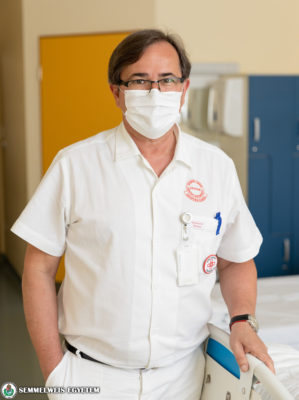 “The staff of the Department of Orthopedics has been continuously involved in the fight against the coronavirus for the past year, and in the meantime, they also had to deal with the care of their own patients throughout the pandemic”, emphasized Dr. György Szőke.
“The staff of the Department of Orthopedics has been continuously involved in the fight against the coronavirus for the past year, and in the meantime, they also had to deal with the care of their own patients throughout the pandemic”, emphasized Dr. György Szőke.
The director highlighted that the Department of Orthopedics had been transformed into a full-time COVID care unit due to the rising number of infections in the second and third waves of the coronavirus. In addition to these tasks, interventions that could not be delayed also had to be performed, such as the treatment of patients with bone and soft tissue tumors, which required a major reorganization. As the director explained, the inpatient care on the second floor of the External Clinical Block was removed to the 1st Department of Surgery and Interventional Gastroenterology, where they were able to carry out those interventions that could not be delayed. He also added that as the largest orthopedic center in Hungary, the operation of the pediatric orthopedic unit also had to be solved, which was temporarily transferred to the Surgical Unit of the 2nd Department of Pediatrics. The outpatient care of the department was relocated to the Szent Rókus Clinical Block.
“The COVID unit with a capacity of 35 beds set up at the Department of Orthopedics focused on the treatment of COVID patients who did not require intensive care. The physicians, residents, nurses, and physiotherapists working at the department were quickly retrained with the help of colleagues specialized in internal medicine”, Dr. György Szőke highlighted.
In the ascending branch of the third wave, the demand for care increased, therefore a COVID unit suitable for intensive care was established at another department of the clinic. As the director explained, the vaccination center of the Central Patient Care Building also operates in the premises of the Department of Orthopedics, and the colleagues also took part in the operation of the vaccination program. According to him, the largest task was the fact that they had to meet new professional challenges, and they had to hold on in a completely new professional field.
“I am extremely grateful for my colleagues for carrying out all of their tasks even in this difficult epidemiological situation”, said Dr. György Szőke.
Due to the favorable epidemiological data and a decline in the extent of COVID care, COVID patient care has been ceased at the majority of the departments, but the university continues to maintain COVID patient care units as required, one of which is the COVID surgical matrix unit operating at the Department of Orthopedics.
“The past year has shown us that if we have the intention, we can meet even the most special professional challenges. With a good organization, cooperation and determination, a team of professionals with a completely different profile is able to meet new professional challenges”, Dr. György Szőke said.
Pálma Dobozi, Bernadett Bódi
Photo: Attila Kovács – Semmelweis University (the featured image is illustration)
Translation: Katalin Illés-Romhányi
